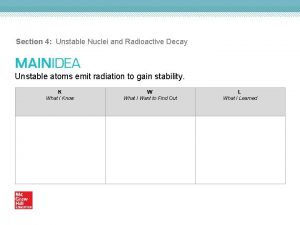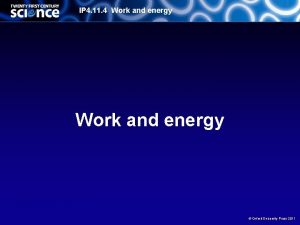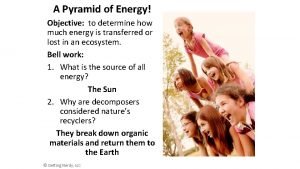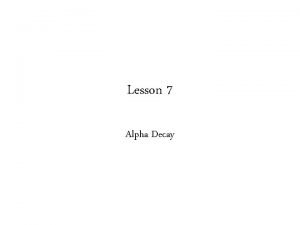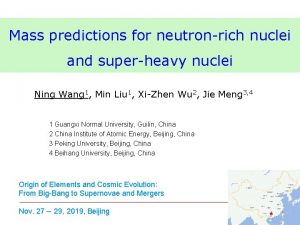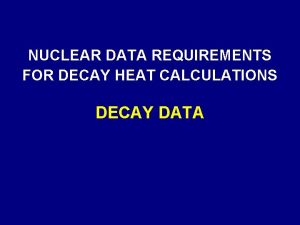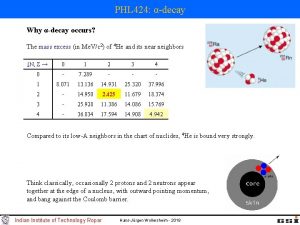Mass Energy Calculations MassEnergy Calculations When nuclei decay











- Slides: 11

Mass Energy Calculations

Mass-Energy Calculations • When nuclei decay, they form products of lower energy. – The change of energy is related to the change in mass, according to the mass-energy equivalence relation derived by Albert Einstein in 1905. – Energy and mass are equivalent and related by the equation Here c is the speed of light, 3. 00 x 108 m/s. www. assignmentpoint. com

Mass-Energy Calculations • When nuclei decay, they form products of lower energy. – If a system loses energy, it must also lose mass. – Though mass loss in chemical reactions is small (10 -12 kg), the mass changes in nuclear reactions are approximately a million times larger. www. assignmentpoint. com

Mass-Energy Calculations • When nuclei decay, they form products of lower energy. – Consider the alpha decay of uranium-238 to thorium 234. 238. 05078 234. 04359 4. 00260 – We have written the atomic mass (in amu) beneath each nuclide symbol. (see Table 21. 3) www. assignmentpoint. com

Mass-Energy Calculations • When nuclei decay, they form products of lower energy. – The change in mass for this reaction, in molar amounts is 238. 05078 www. assignmentpoint. com 234. 04359 4. 00260

Mass-Energy Calculations • When nuclei decay, they form products of lower energy. – The change in mass for this reaction, in molar amounts is 238. 05078 234. 04359 4. 00260 – The energy change for 1 mol of uranium-238 is www. assignmentpoint. com

Mass-Energy Calculations • The equivalence of mass and energy explains the fact that the mass of an atom is always less than the sum of the masses of its constituent particles. – When nucleons come together to form a stable nucleus, energy is released. – According to Einstein’s equation, there must be a corresponding decrease in mass. www. assignmentpoint. com

Mass-Energy Calculations • The binding energy of a nucleus is the energy needed to break a nucleus into its individual protons and neutrons. – Thus the binding energy of the helium-4 nucleus is the energy change for the reaction 4. 00260 2(1. 00728) 2(1. 008665) – Both binding energy and the corresponding mass defect are reflections of the stability of the nucleus. www. assignmentpoint. com

Mass-Energy Calculations • The binding energy of a nucleus is the energy needed to break a nucleus into its individual protons and neutrons. – Figure 21. 16 shows the values of binding energy per nucleon plotted against the mass number for various nuclides. – Note that nuclides near mass number 50 have the largest binding energies per nucleon. www. assignmentpoint. com

Mass-Energy Calculations • The binding energy of a nucleus is the energy needed to break a nucleus into its individual protons and neutrons. – For this reason, heavy nuclei might be expected to split to give lighter nuclei, while light nuclei might be expected to combine to form heavier nuclei. www. assignmentpoint. com

Figure 21. 16 Plot of binding energy per nucleon versus mass number www. assignmentpoint. com
 How unstable atoms gain stability
How unstable atoms gain stability Beta decay
Beta decay Growth and decay factors
Growth and decay factors Types of connections in steel structures
Types of connections in steel structures Energy energy transfer and general energy analysis
Energy energy transfer and general energy analysis Energy energy transfer and general energy analysis
Energy energy transfer and general energy analysis Energy calculations oxford
Energy calculations oxford Energy pyramid calculations
Energy pyramid calculations Bond energy worksheet
Bond energy worksheet Stoichiometric calculations
Stoichiometric calculations Atomic number mass
Atomic number mass Is atomic mass and relative atomic mass the same
Is atomic mass and relative atomic mass the same
